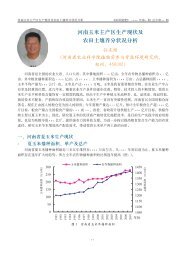Americas and Oceania Group - International Plant Nutrition Institute
Americas and Oceania Group - International Plant Nutrition Institute
Americas and Oceania Group - International Plant Nutrition Institute
You also want an ePaper? Increase the reach of your titles
YUMPU automatically turns print PDFs into web optimized ePapers that Google loves.
Environmentally Sound Fertilization Technology for Vegetables <strong>and</strong> Banana<br />
Project Leader: Prof. Zhang Mingqin, Fujian Academy of Agricultural Sciences Soil <strong>and</strong> Fertilizer <strong>Institute</strong>, Fuzhou,<br />
Fujian. E-mail: Zhangmq2001@163.com<br />
Project Cooperators: Li Juan, Kong Qingbo, <strong>and</strong> Chen Yanhua<br />
Vegetable planting area in Fujian Province has reached 670,000 ha with a total production of 14,530,100 t,<br />
<strong>and</strong> is valued at USD 33 billion. However, imbalanced fertilization practices usually followed by farmers here<br />
affect the environment negatively. This study was conducted by the Soil <strong>and</strong> Fertilization <strong>Institute</strong> of Fujian<br />
Academy of Agricultural Science with the objectives of demonstrating efficient fertilization technology for<br />
vegetables <strong>and</strong> banana in Fujian.<br />
Results showed that balanced fertilization helped attain maximum lettuce yield of 46 t/ha (8.7% increase<br />
over farmers’ practice) with net income of USD 1,509/ha. For banana, the results showed that average yield<br />
of balanced fertilization plots was 43.8 t/ha. Nitrogen fertilization contributed banana yield 0.8 to 4.2 t/ha, P<br />
fertilization contributed 0.2 to 4.4 t/ha <strong>and</strong> K fertilization contributed 1.2 to 3.8 t/ha over farmers’ practice. A<br />
control plot without fertilizer revealed that soil indigenous nutrient supplies contributed about 50% of banana<br />
yield.<br />
A long-term field experiment has been running in Pinghe county since 2008 with green beans-cucumberearly<br />
rice rotation. Unfertilized plots showed that the soil indigenous fertility contributed about 61% to<br />
vegetable yield <strong>and</strong> about 80% to rice yield. The residual effect of N <strong>and</strong> P fertilizers applied to the two<br />
vegetable crops in rotation, had a positive impact on the yield of early rice yield. No fertilization in the<br />
rice growing season obtained the highest economic profit with less than 10% lower yield, reflecting the<br />
large supply of residual nutrients left after the two vegetable crops. After cucumber, soil NO 3- -N <strong>and</strong> P<br />
concentrations of soil water were 1,125 mg/L <strong>and</strong> 2.267 mg/L, <strong>and</strong> after rice planting season, it dropped to<br />
143.5 mg/L <strong>and</strong> 0.435 mg/L. Therefore, in this rotation, rice planting not only greatly increased fertilization<br />
efficiency, but also greatly reduced the NO 3- -N <strong>and</strong> P concentrations of soil water. In this rotation with<br />
optimum fertilization treatment, N loss was reduced by 67.7 kg/ha <strong>and</strong> N use efficiency increased from 45.1<br />
to 65.6%, while P loss reduced by 6.6 kg/ha <strong>and</strong> P use efficiency increased from 17.9 to 26.5% over farmers’<br />
practice. Fujian-10<br />
Study on the <strong>Plant</strong> <strong>Nutrition</strong> Characters <strong>and</strong> Management Technology for High Yield <strong>and</strong> Quality of Peanuts<br />
Project Leader: Li Zhiyu, Chinese Academy of Agricultural Science Oil Crops Research <strong>Institute</strong>, Wuhan, Hubei.<br />
E-mail: Zylimail@oilcrops.cn<br />
Project Cooperators: Liao Boshou, Li Jun, <strong>and</strong> Ma Hao<br />
Peanut is an important oil <strong>and</strong> cash crop in China that was sown in 42.5 M ha area with a total production<br />
of 14.29 M t in 2008. Peanut oil accounted for 23% of the domestic vegetable oil production in China, next<br />
only to Rapeseed oil. Hubei is one of the main peanut growing provinces in China. This study on balanced<br />
fertilization of peanut was successfully carried out by the Oil Crops Research <strong>Institute</strong>, Chinese Academy of<br />
Agricultural Sciences in Yicheng, Xiangyang, <strong>and</strong> Hong’an counties of Hubei province in 2011.<br />
Results indicated that K <strong>and</strong> lime are the main limiting factors for peanut growing in these regions.<br />
Compared with the common farmers’ practice, an additional application of potash increased peanut yields by<br />
6.9% while lime application significantly increased summer peanut yields by 23%. Field experiment results<br />
showed that foliar application of Fe, Mn, <strong>and</strong> Mo had no significant effect in reducing peanut’s disease of leaf<br />
etiolation. Film-mulching technology increased seed germination, seedling number, <strong>and</strong> yield by 14.3, 17.1,<br />
<strong>and</strong> 28.4%, respectively, than no mulching treatment. Hubei-28<br />
70 IPNI Interpretive Summaries

















